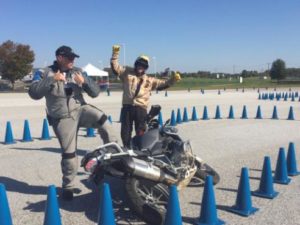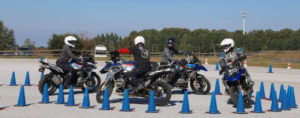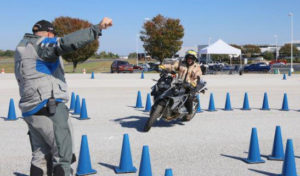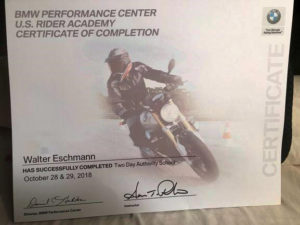Recently I had the opportunity to attend the first two day Authority School Training program designed by the folks at the BMW Performance Center U.S. Rider Academy, for non LEO (Law Enforcement Officer) participants. If you’ve ever watched police motorcycle riders demonstrating their skills riding through what look like impossibly tight turns, narrow alleys, and follow the leader events and wondered what it takes to get to that level, then the Authority School program is just the thing for you.
Rider Academy trainer Aaron Rankin and Ricardo Rodriguez presented a teaser session at the Iowa BMW National rally. I had the good fortune to attend and it convinced me of the value a full immersion course would provide me to get my riding skills back to a level of confidence that was sorely lacking after a unfortunate bike drop.
I suffered a broken ankle the previous year while showing off my supposed skills to the folks at my daily Mickey D’s morning coffee klatch gathering. It left me wondering if I really had the ability to keep riding the way I wanted to. So much for getting over confident and showing off for the girls, which my wife has not let me forget. It was a long ride in the back of my jeep to the hospital with all the subtlety a forty six year marriage can muster. But she’s a good sport and has always had my back when I’ve tried a challenge, so was supportive of my decision to sign up for the two day Authority Training course, even though I think she would have rather I take up golf instead.
So off I went to the Performance Center in South Carolina. I chose the end of October not only because of cooler weather, but also because in my opinion, motorcycle skills are perishable if not practiced on a continuing basis, and I had been doing donuts in any empty parking lot I could find open ever since my teaser course in July. So it was important to me to get the full immersion training before the cold months of winter place a damper on riding, although I tend to ride all winter long, with the aid of electronics.
The first day of training started with a short classroom discussion of balance techniques, course set-up and introduction to the bikes provided by the Performance Center if you pick that option. Based on the many times I dropped the bike during the two days, it was money well spent. I also have plans to purchase a new 1200 GS at sometime in the near future, so it was a chance to get some seat time on the bike to make sure it was the right bike for me.
 Once the initial discussion was complete, the rest of the two days were spent on the bike, picking up the bike, or resting in a chair on the course, trying to build up energy for the next challenge. Ninety-five percent of the time was spent on the bikes, so seat time was not a problem. Keeping my body in the seat was a challenge because of sore muscles from picking her up many times. I found the quick tutorial on picking a bike up at the beginning of day one to be especially appropriate. Although the instructors are always available to help pick the bike up, or actually pick it up for you, my inner sense of stubbornness told me if I dropped her, I picked her up.
Once the initial discussion was complete, the rest of the two days were spent on the bike, picking up the bike, or resting in a chair on the course, trying to build up energy for the next challenge. Ninety-five percent of the time was spent on the bikes, so seat time was not a problem. Keeping my body in the seat was a challenge because of sore muscles from picking her up many times. I found the quick tutorial on picking a bike up at the beginning of day one to be especially appropriate. Although the instructors are always available to help pick the bike up, or actually pick it up for you, my inner sense of stubbornness told me if I dropped her, I picked her up.
However, with a three to one student to instructor ratio there was always timely feedback on what you’re doing right or wrong.
 By the end of Day One, three of the group had built up enough confidence to follow-the-leader into some of the course challenges, but I opted to wait until the next day towards the end to enter with the herd. By that time there wasn’t anyone around to snap a photo, but I will never forget the feeling of accomplishment of not running into anyone in the tight space or dropping the bike and scattering everyone through the cones.
By the end of Day One, three of the group had built up enough confidence to follow-the-leader into some of the course challenges, but I opted to wait until the next day towards the end to enter with the herd. By that time there wasn’t anyone around to snap a photo, but I will never forget the feeling of accomplishment of not running into anyone in the tight space or dropping the bike and scattering everyone through the cones.
The morning of Day Two involved open practice for a couple of hours in the morning to build memory skills before the actual qualification testing, so after working out the kinks and sore muscles, I must admit that the practice started to click. All of a sudden, the cones were still standing after moving through the challenges, the bike was heaving a sigh of relief that she hadn’t had to nap on the ground and with sunny skies and cool morning air, I knew that I had made the right decision to invest in the training.
 What a great feeling to be able to confidently turn a bike in a fifteen foot circle, or start from a dead stop to exit stage left or right in a simulated rear end accident, or just making a tight u-turn for when riding in a group ride and the leader makes a wrong turn down a dead end road. We’ve pretty much all been there, and even may have been that ride leader who really feels bad that someone dumped their bike because of a wrong turn, eh!
What a great feeling to be able to confidently turn a bike in a fifteen foot circle, or start from a dead stop to exit stage left or right in a simulated rear end accident, or just making a tight u-turn for when riding in a group ride and the leader makes a wrong turn down a dead end road. We’ve pretty much all been there, and even may have been that ride leader who really feels bad that someone dumped their bike because of a wrong turn, eh!
The second half of Day Two moved the action from the cone area to the speed track where we practiced panic stops from 50 to 60 miles per hour, obstacles avoidance and counter steering. Now, most of us riding for any length of time probably understand the theory of how to do these things, but really never have the chance to practice them unless confronted with a real-life threat.
I must say, it’s a real adrenaline rush to counter steer through a quarter mile of cones at thirty to forty miles per hour at thirty foot intervals, as that thirty foot passes mighty quick at that speed. And actually trying to avoid a simulated big rig truck with a panic stop coupled with a counter steer followed by another panic stop is something I hope I never have to do on the highway, but now have a good idea of what it would take to keep from ending up underneath that semi. So there is lots to practice in the months ahead to first lock in the memory response, and them keep my skills from becoming perishable.
At the end of the day, I found that my impressions about the value offered by the course were spot on. I know my riding buddies kind of rolled their eyes when they heard I had signed up right away at the national rally, as I have a bit of a reputation for being frugal, but I found the value provided by Aaron and the center’s instructors to be priceless.
 I’ve regained my riding confidence and expect the training to help me anticipate and mitigate road conditions that I may not have been able to overcome with my former riding skills. Hopefully as I move towards the 70 year mark, training classes such as provided by the Riding Academy will help keep me on the road enjoying the open fresh air and freedom that only a seasoned rider would understand. And yes, I did manage to pass the final test with only a few toe touches and one minor incident on the smallest circle of the snowman challenge…….Cheers.
I’ve regained my riding confidence and expect the training to help me anticipate and mitigate road conditions that I may not have been able to overcome with my former riding skills. Hopefully as I move towards the 70 year mark, training classes such as provided by the Riding Academy will help keep me on the road enjoying the open fresh air and freedom that only a seasoned rider would understand. And yes, I did manage to pass the final test with only a few toe touches and one minor incident on the smallest circle of the snowman challenge…….Cheers.
